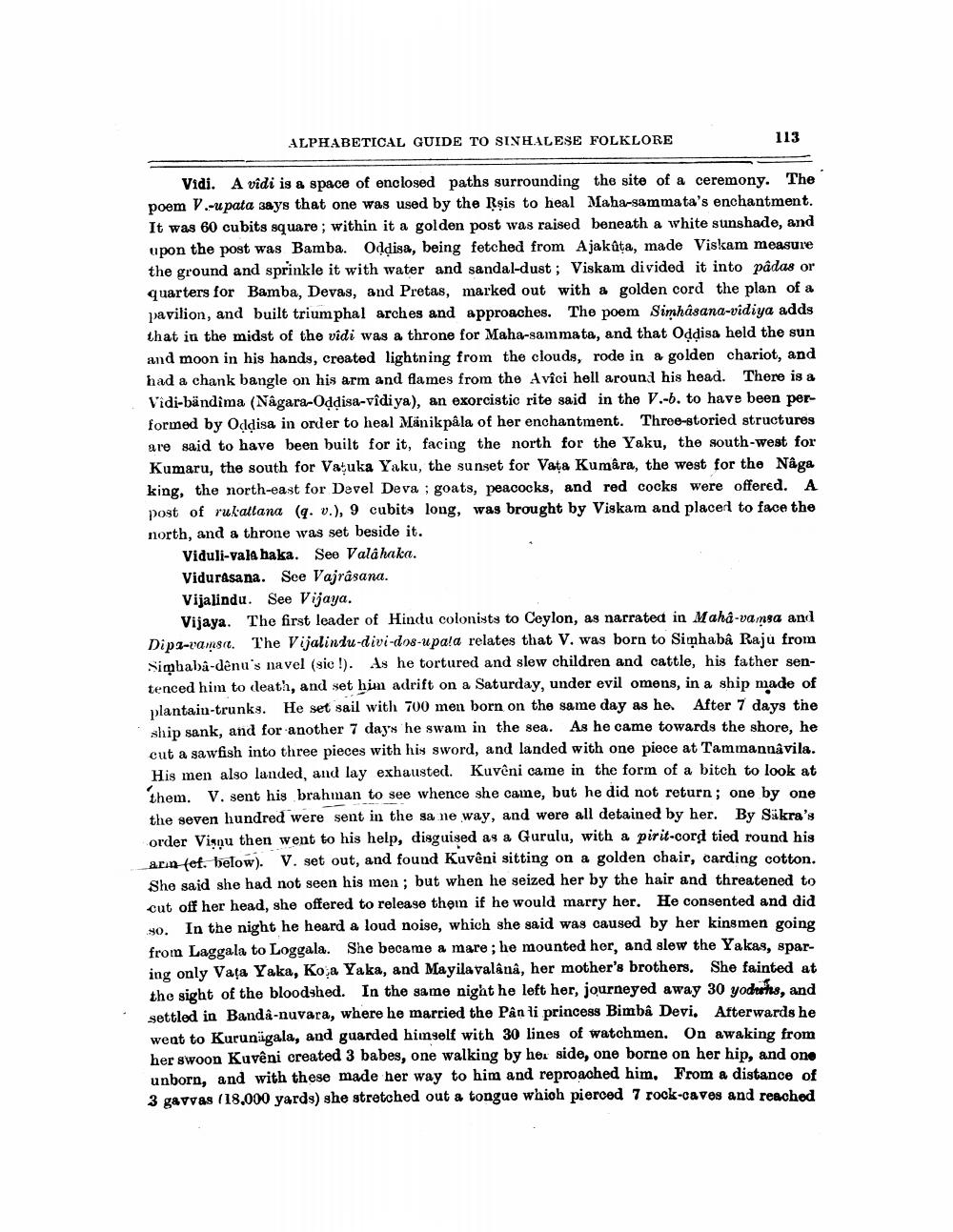________________
ALPHABETICAL GUIDE TO SINHALESE FOLKLORE
113
Vidi. A vidi is & space of enclosed paths surrounding the site of a ceremony. The poem V.-upata says that one was used by the Rsis to heal Maha-sammata's enchantment. It was 60 cubits square; within it a golden post was raised beneath a white sunshade, and upon the post was Bamba. Oddisa, being fetched from Ajakâta, made Viskam measure the ground and sprinkle it with water and sandal-dust; Viskam divided it into pâdas or quarters for Bamba, Devas, and Pretas, marked out with a golden cord the plan of a pavilion, and built triumphal arches and approaches. The poem Simhâsana-vidiya adds that in the midst of the vidi was a throne for Maha-sammata, and that Oddisa held the sun and moon in his hands, created lightning from the clouds, rode in a golden chariot, and had a chank bangle on his arm and flames from the Avici hell around his head. There is a Vidi-bändima (Nâgara-Oddisa-vidiya), an exorcistic rite said in the V.-b. to have been performed by Oddisa in order to heal Manikpala of her enchantment. Three-storied structures are said to have been built for it, facing the north for the Yaku, the south-west for Kumaru, the south for Vacuka Yaku, the sunset for Vata Kumāra, the west for the Nâga king, the north-east for Devel Deva ; goats, peacocks, and red cocks were offered. A post of rukatlana (q. v.), 9 cubita long, was brought by Viskam and place to face the north, and a throne was set beside it.
Viduli-vala haka. See Vala haka. Vidurasana. See Vajrasana. Vijalindu. See Vijaya.
Vijaya. The first leader of Hindu colonists to Ceylon, as narrated in Maha-vamsa and Dipl-amsıt. The Vijalindu-divi-dos-upa!a relates that V. was born to Simhabâ Raju from Simbaba-denu's navel (sic!). As he tortured and slew children and cattle, his father sentenced him to death, and set him adrift on a Saturday, under evil omens, in a ship made of plantain-trunks. He set sail with 700 men born on the same day as he. After 7 days the ship sank, and for another 7 days he swam in the sea. As he came towards the shore, he cut a gawfish into three pieces with his sword, and landed with one piece at Tammannavila. His men also landed, and lay exhausted. Kuvêni came in the form of a bitch to look at them. V. sent his brahman to see whence she came, but he did not return; one by one the seven hundred were sent in the sa ne way, and were all detained by her. By Sakra's order Visnu then went to his help, disguised as a Gurulu, with a pirit-cord tied round his arın (ef. below). V. set out, and found Kuvêni sitting on a golden chair, carding cotton. She said she had not seen his men ; but when he seized her by the hair and threatened to cut off her head, she offered to release them if he would marry her. He consented and did HO. In the night he heard a loud noise, which she said was caused by her kinsmen going from Laggala to Loggala. She became a mare; he mounted her, and slew the Yakas, sparing only Vata Yaka, Ko,a Yaka, and Mayila valâna, her mother's brothers. She fainted at the sight of the bloodshed. In the same night he left her, journeyed away 30 vodohs, and settled in Banda-nuvara, where he married the Pân li princess Bimbâ Devi. Afterwards he weat to Kurunägala, and guarded himself with 30 lines of watchmen. On awaking from her swoon Kuvêni created 3 babes, one walking by her side, one borne on her hip, and one unborn, and with these made her way to him and reproached him, From a distance of 3 gavvas (18.000 yards) she stretched out a tongue which pierced 7 rock-caves and reached




